Testimony for Little Hoover Commission Hearing on the California Environmental Quality Act
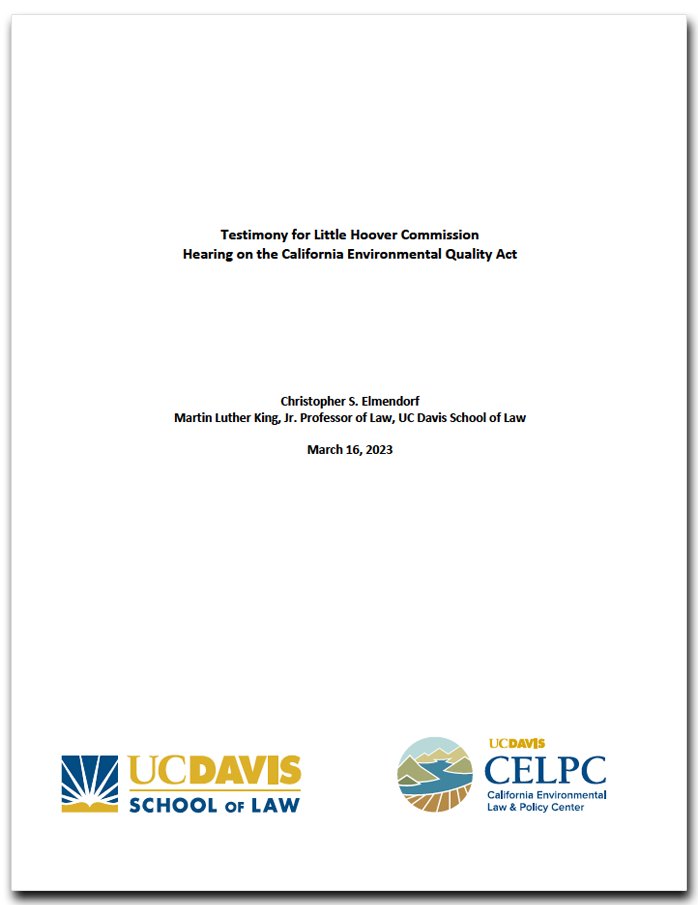
Christopher S. Elmendorf, Martin Luther King, Jr. Professor of Law, UC Davis
“I Would, If Only I Could” How Cities Can Use California’s Housing Element to Overcome Neighborhood Resistance to New Housing

Christopher S. Elmendorf, Martin Luther King, Jr. Professor of Law, UC Davis
Eric Biber, Professor of Law, UC Berkeley
Paavo Monkkonen, Associate Professor of Urban Planning and Public Policy, UCLA Luskin School of Public Affairs
Moira O’Neill, Senior Research Fellow, Center for Law, Energy & the Environment, UC Berkeley
The Housing Element Law requires cities to periodically adopt a state-approved plan, called a housing element, to accommodate the city’s share of regional housing need. We argue that housing elements have substantial and underexplored potential to help local officials overcome the pathologies of “normal” land use politics.
This report explains how California’s Housing Element Law can be used by city councils and planning departments that understand the need to remove local barriers to housing supply and access to opportunity, but find themselves constrained by neighborhood-level opposition to change.
Link to the full paper- https://www.lewis.ucla.edu/research/overcoming-neighborhood-resistance/
Making It Work: Legal Foundations for Administrative Reform of California’s Housing Framework
Issue Brief – Dec. 2019; 46 Ecology Law Quarterly
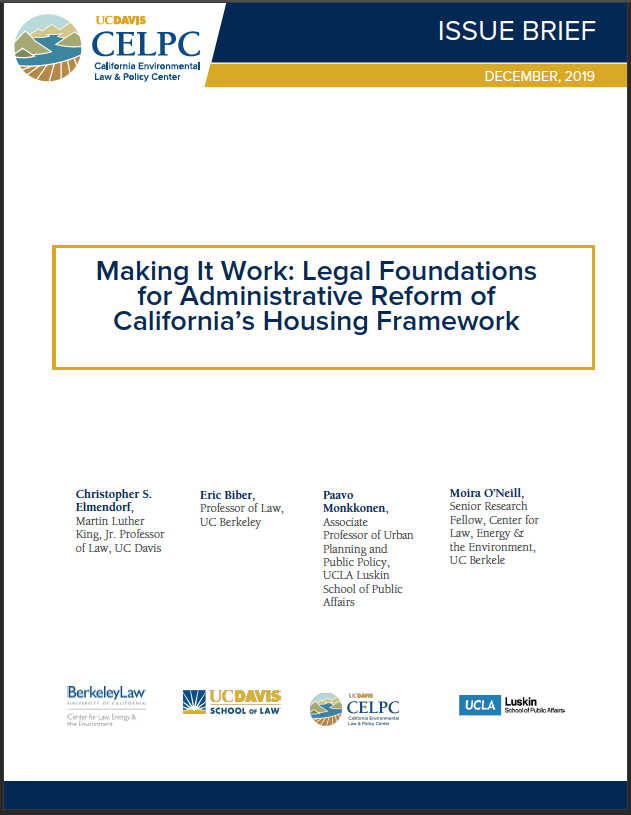
Christopher S. Elmendorf, UC Davis, Eric Biber, UC Berkeley, Paavo Monkkonen, UCLA, and Moira O’Neill, UC Berkeley
Since 1980, California has had an ambitious planning framework on the books to make local governments accommodate their fair share of “regional housing need” “for all income levels.” The framework relied, however, on a rickety and complicated conveyor belt for converting regional housing targets into actual production. Superintending the conveyor belt was an administrative entity, the Department of Housing and Community Development (HCD), whose rules had no legal effect, and whose judgments about the adequacy of a local government’s housing plan received virtually no deference from the courts. In this Issue Brief and the companion law review article, Elmendorf, Biber, Monkkonen and O’Neill explain that HCD’s position has been fundamentally transformed by a series of individually modest but fortuitously complementary bills enacted from 2017-2019. HCD now has authority to strengthen, simplify, and supplement the conveyor belt in ways that would have been (legally speaking) unimaginable just a few years ago. For example, (1) HCD may require local governments to account for development probabilities in their housing plans, thereby effectively doubling the amount of “zoned capacity” that local governments must provide; (2) HCD may promulgate metrics and standards for whether the supply of housing within a local government’s territory is substantially constrained, and thereafter refuse to certify the housing plans of poorly performing localities unless the local government commits to ministerial review of ordinary multifamily housing projects; and (3) HCD may establish “standards of equivalence” for translating form-based and density-based zoning, and thereby thwart local efforts to evade state housing laws by imposing approval conditions that greatly reduce a housing project’s size without necessarily reducing its unit count.
Access the Issue Brief here and the full paper here.
Auctioning the Upzone: A New Strategy to Induce Local Government Compliance with State Housing Policies
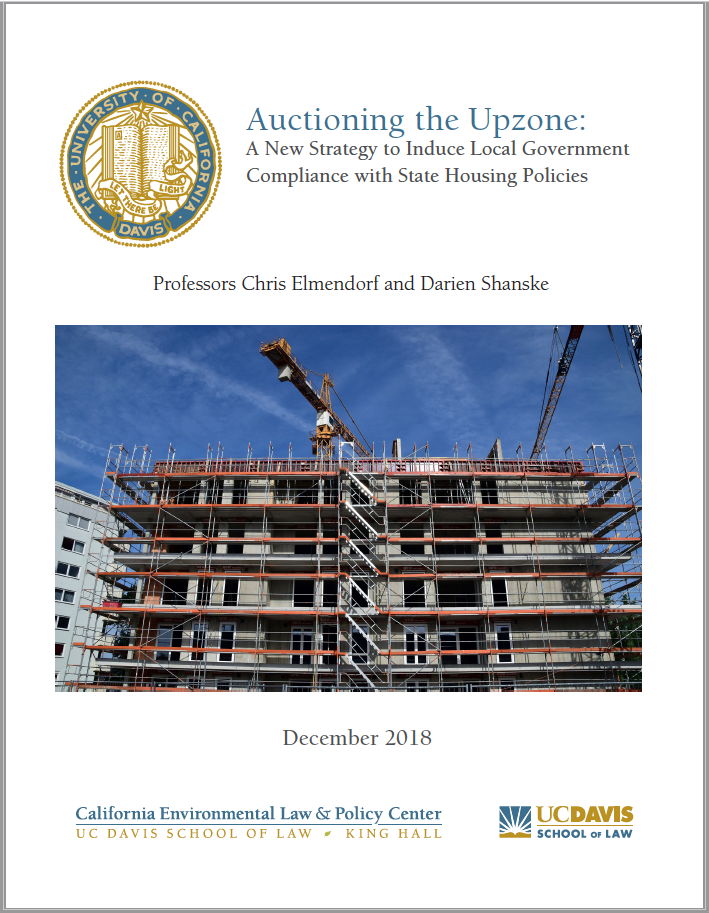
In this white paper, Professors Elmendorf and Shanske propose a new tool—the development rights auction—to get local governments to comply with state policies favoring high-density housing near transit and job centers. Local governments that rezone pursuant to state law would be authorized to sell the newly created buildable space, in the form of tradeable development allowances. This arrangement would give local governments a fiscal incentive to allow dense new housing in the targeted areas, and to streamline what are now cumbersome and discretionary permitting procedures. It would also facilitate state oversight of local development regulation, as the price at which development allowances trade (relative to the price of finished housing) would provide a valuable, forward-looking signal about the existence of hidden local barriers to the development of nominally-permitted housing. The right to auction development allowances would also give the most supplied-constrained cities a political incentive to support state-directed upzoning, and would bury the argument that state upzoning bills such as SB 827 are giveaways to developers. After explaining these claims, Elmendorf and Shanske respond to potential legal and policy objections to their proposal. Access the report here.
California's Proposition 3: A Policy Analysis
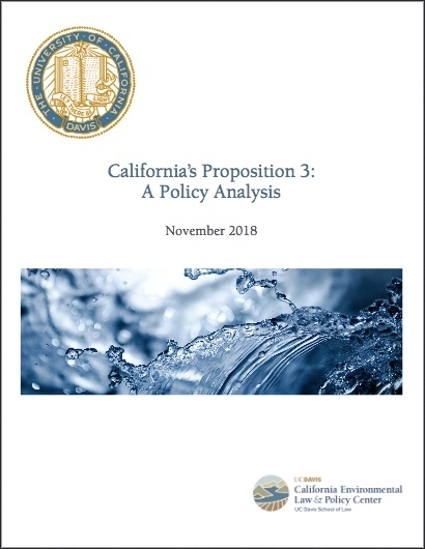
This report, “California’s Proposition 3: A Policy Analysis,” is a white paper prepared by Sunshine Saldivar, J.D., the Center's 2018-2019 Environmental Law Fellow. The Center does not take an advocacy position for or against Proposition 3. Instead, this white paper offers a legal and policy analysis to help inform the public debate on Proposition 3, in hopes that the analysis can be of use to California voters and interested observers leading up to the state’s general election on November 6, 2018. Proposition 3 is a water bond initiative that will appear on California’s November 6th, 2018 general election ballot. Access the report here.
More Power to the Wealthy: Renewable Energy Tax Programs, Market Distortions, and the Ramifications on the Cost of Electricity
This journal article written by 2016-17 Fellow Dan Quinley, originally published in 40 Environs Environmental Law and Policy Journal 185 (May 2017), details the availabe information as of early 2017 of renewable energy tax programs at the federal and state levels. It discusses the distorting effect these programs have on the market and the potential ramifications of these programs for availability of affordable electricity. This article may be downloaded here.
Senate Bill 4: A Past and Present Look at Hydraulic Fracturing in California
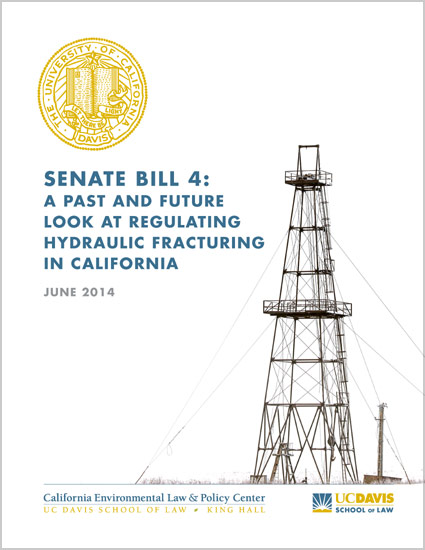
This report, “Senate Bill 4: A Past and Future Look at Regulating Hydraulic Fracturing in California,” was prepared by Michael Murza, 2013-14 Environmental Law Fellow. The report analyzes the current controversy over hydraulic fracturing (“fracking”) and related drilling technologies that are currently producing unprecedented levels of oil and gas in California and other parts of the U.S.; explains the origins and key provisions of SB 4 (Pavley), landmark California legislation that creates a comprehensive regulatory program and public disclosure requirements for fracking conducted in that state; discusses the ongoing regulatory initiatives that are currently underway to implement SB 4; and identifies several important ambiguities and unanswered questions regarding the California legislation and implementing regulations. It is hoped that this report will inform the ongoing public debate over fracking in California, the U.S. and internationally, and be of use to policymakers, the media and interested members of the public. The report may be downloaded here.
Lessons from the West: Fracking and Water Resources
This short paper, “Lessons from the West: Fracking and Water Resources,” was prepared by Miles Hogan, Environmental Law Fellow. The paper broadly examines how water law in western states applies to the overall use of water in fracking, and it raises issues with current and future regulation and litigation in this area. The paper was compiled for a presentation given on November 9, 2012 at a workshop put on by Dividing the Waters and The National Judicial College. This project demonstrates the Center's commitment to partnering with educators and policy institutes, and to providing a meaningful dialogue in key areas of environmental law and policy. This paper may be downloaded here.
California's Proposition 37: A Legal & Policy Analysis
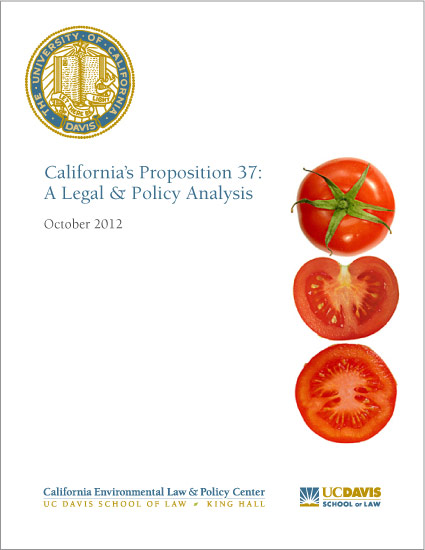
The Center has published a new white paper examining California’s Proposition 37, formally titled “The California Right to Know Genetically Engineered Food Act.” Proposition 37 is an initiative measure that will appear on California’s November 6 th, 2012 general election ballot. The report does not argue in favor of or against Proposition 37. Instead, it is intended to serve as an independent and objective analysis of the initiative, to help inform the public debate over the measure and be of use to California voters and interested observers.
Proposition 37 is the most important environmental measure appearing on California’s crowded November election ballot. It is attracting national attention as well as millions of dollars in campaign contributions from both supporters and opponents of the initiative. That’s because the proponents of Proposition 37 hope, and those opposing the measure fear, that if enacted the initiative will prompt similar laws in other states and, perhaps, at the national level. Hopefully, “California’s Proposition 37: A Legal & Policy Analysis,” published in October 2012, will contribute to a thoughtful public debate over this important initiative. Access the report here.
Rocky Mountain Farmers Union v. Goldstene: Brief of Amici Curiae Professors of Environmental Law in Support of Appellants
In June 2012 a group of environmental law professors, including Professor Rick Frank, submitted a brief in support of the California Air Resources Board's low carbon fuel standard. View the report here.
Defining Good Infill
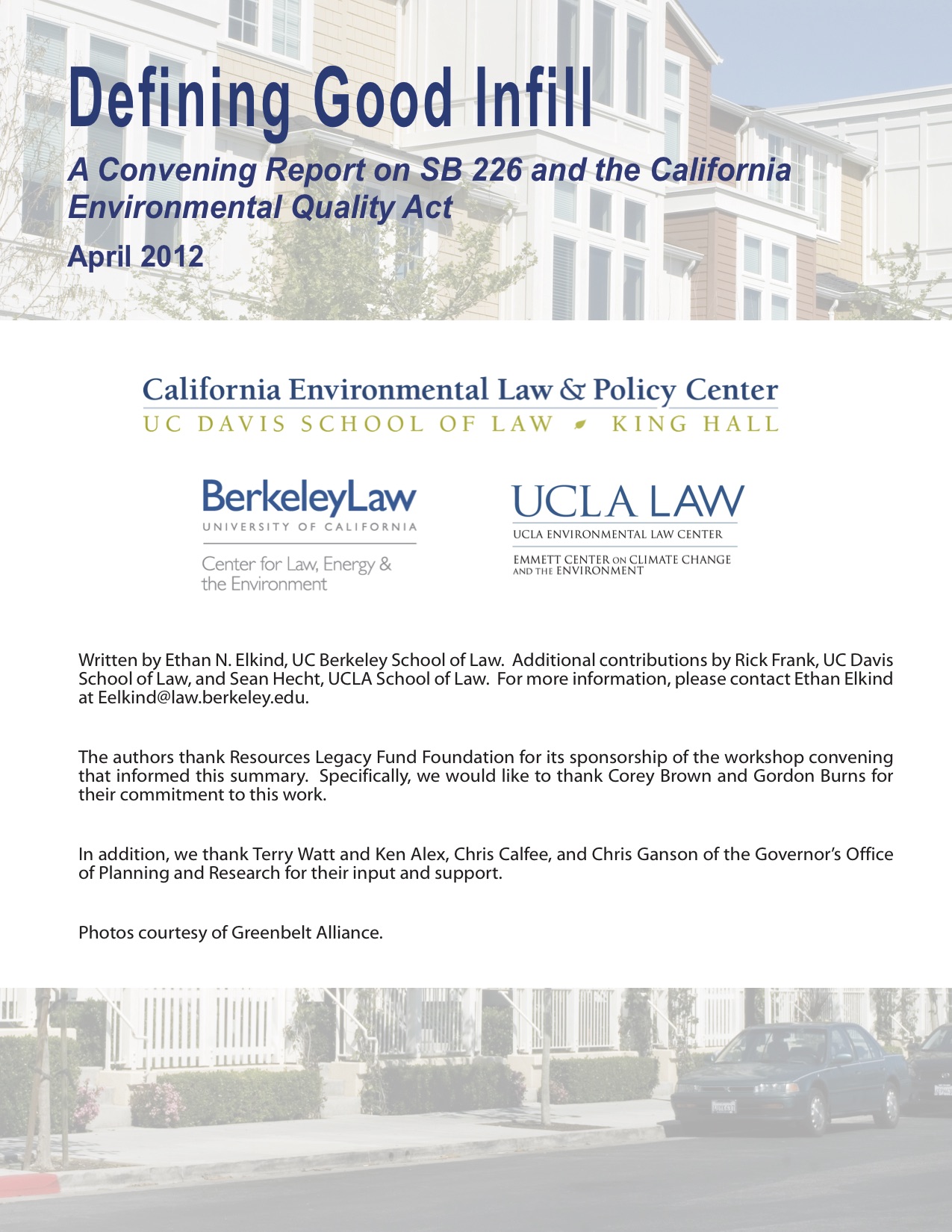
This report, A Convening Report on SB 226 and the California Environmental Quality Act, provides a brief overview of SB 266 and its implementation and a summary from a convening at UC Berkeley on March 9, 2012. Authors Ethan N. Elkind, Rick Frank, and Sean Hecht published this report following the meeting to provide guidance for the development of regulations by the Governor's Office of Planning and Research and to inform the public on the bill. The report may be accessed here.
Opinion Editorials regarding Proposition 26
In November 2010, California voters enacted Proposition 26, an initiative measure that was largely overshadowed by other, more heavily-publicized measures on last fall's general election ballot. But Proposition 26, which mandates that most future state and local fee systems can only be enacted by a two thirds vote of the California Legislature or local voters, will have a profound effect on a variety of public health, safety and environmental protection measures. Proposition 26 is likely to have an especially pronounced effect on California environmental programs, which in recent years have relied heavily on "polluter pays"-based fee systems to fund them.
Two opinion columns relating to Proposition 26 were published in conjunction with the Center. In “Voter Confusion and the Single-Subject Rule: Proposition 26 as a Test Case” (December 2010), King Hall Law Professor Christopher Elmendorf suggests that the initiative measure may be unconstitutional under California's "single subject rule." In “Proposition 26: California’s Stealth Initiative” (October 29, 2010) Director Richard Frank, discusses the background of Proposition 26, as well as its particular, anticipated effects on a variety of state and local environmental programs.
Other Publications
- "Justices Reject States' Climate Change Nuisance Lawsuit" by Richard M. Frank, June, 28, 2011.
- "The Legacy of Arnold Schwarzenegger" by Richard M. Frank, December 15, 2010.
- "Preserving the Delta smelt via ESA is constitutional" by Richard M. Frank, September 10, 2010.
- "Justice Stevens' Abiding Environmental Legacy" by Richard M. Frank, May 10, 2010.
